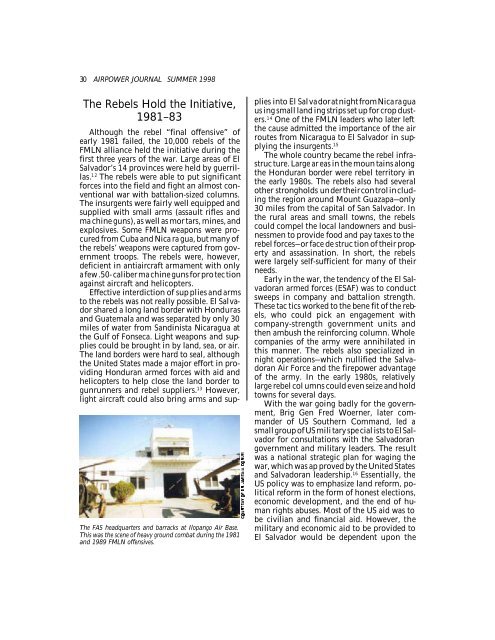The Air War in El Salvador - Air and Space Power Journal
The Air War in El Salvador - Air and Space Power Journal
The Air War in El Salvador - Air and Space Power Journal
Create successful ePaper yourself
Turn your PDF publications into a flip-book with our unique Google optimized e-Paper software.
30 AIRPOWER JOURNAL SUMMER 1998<br />
<strong>The</strong> Rebels Hold the Initiative,<br />
1981–83<br />
Al though the rebel “f<strong>in</strong>al offen sive” of<br />
early 1981 failed, the 10,000 rebels of the<br />
FMLN alli ance held the <strong>in</strong>itia tive dur<strong>in</strong>g the<br />
first three years of the war. Large areas of <strong>El</strong><br />
Sal va dor’s 14 prov<strong>in</strong>ces were held by guerrillas.<br />
12 <strong>The</strong> rebels were able to put signifi cant<br />
forces <strong>in</strong>to the field <strong>and</strong> fight an almost conven<br />
tional war with battalion-sized columns.<br />
<strong>The</strong> <strong>in</strong>sur gents were fairly well equipped <strong>and</strong><br />
sup plied with small arms (assault rifles <strong>and</strong><br />
ma ch<strong>in</strong>e guns), as well as mor tars, m<strong>in</strong>es, <strong>and</strong><br />
ex plo sives. Some FMLN weapons were procured<br />
from Cuba <strong>and</strong> Nica ra gua, but many of<br />
the rebels’ weapons were captured from govern<br />
ment troops. <strong>The</strong> rebels were, however,<br />
de fi cient <strong>in</strong> anti air craft arma ment with only<br />
a few .50- caliber ma ch<strong>in</strong>e guns for pro tec tion<br />
aga<strong>in</strong>st aircraft <strong>and</strong> helicop ters.<br />
Ef fec tive <strong>in</strong>ter dic tion of sup plies <strong>and</strong> arms<br />
to the rebels was not really possi ble. <strong>El</strong> <strong>Salvador</strong><br />
shared a long l<strong>and</strong> border with Hondu ras<br />
<strong>and</strong> Guate mala <strong>and</strong> was separated by only 30<br />
miles of water from S<strong>and</strong><strong>in</strong>i sta Nicara gua at<br />
the Gulf of Fonseca. Light weapons <strong>and</strong> supplies<br />
could be brought <strong>in</strong> by l<strong>and</strong>, sea, or air.<br />
<strong>The</strong> l<strong>and</strong> borders were hard to seal, although<br />
the United States made a major effort <strong>in</strong> provid<br />
<strong>in</strong>g Hondu ran armed forces with aid <strong>and</strong><br />
heli cop ters to help close the l<strong>and</strong> border to<br />
gun run ners <strong>and</strong> rebel suppli ers. 13 However,<br />
light aircraft could also br<strong>in</strong>g arms <strong>and</strong> sup-<br />
<strong>The</strong> FAS headquarters <strong>and</strong> barracks at Ilopango <strong>Air</strong> Base.<br />
This was the scene of heavy ground combat dur<strong>in</strong>g the 1981<br />
<strong>and</strong> 1989 FMLN offensives.<br />
plies <strong>in</strong>to <strong>El</strong> Sal va dor at night from Nica ra gua<br />
us <strong>in</strong>g small l<strong>and</strong> <strong>in</strong>g strips set up for crop dusters.<br />
14 One of the FMLN leaders who later left<br />
the cause admit ted the impor tance of the air<br />
routes from Nicara gua to <strong>El</strong> Salva dor <strong>in</strong> supply<br />
<strong>in</strong>g the <strong>in</strong>sur gents. 15<br />
<strong>The</strong> whole country became the rebel <strong>in</strong>frastruc<br />
ture. Large ar eas <strong>in</strong> the moun ta<strong>in</strong>s along<br />
the Hondu ran border were rebel terri tory <strong>in</strong><br />
the early 1980s. <strong>The</strong> rebels also had several<br />
other strongholds un der their con trol <strong>in</strong> clud<strong>in</strong>g<br />
the region around Mount Guazapa—only<br />
30 miles from the capital of San Salva dor. In<br />
the rural areas <strong>and</strong> small towns, the rebels<br />
could compel the local l<strong>and</strong>own ers <strong>and</strong> bus<strong>in</strong>ess<br />
men to provide food <strong>and</strong> pay taxes to the<br />
rebel forces—or face de struc tion of their property<br />
<strong>and</strong> assas si na tion. In short, the rebels<br />
were largely self-sufficient for many of their<br />
needs.<br />
Early <strong>in</strong> the war, the tendency of the <strong>El</strong> Salva<br />
doran armed forces (ESAF) was to conduct<br />
sweeps <strong>in</strong> company <strong>and</strong> battal ion strength.<br />
<strong>The</strong>se tac tics worked to the bene fit of the rebels,<br />
who could pick an engage ment with<br />
company- strength govern ment units <strong>and</strong><br />
then ambush the re<strong>in</strong> forc <strong>in</strong>g column. Whole<br />
com pa nies of the army were anni hi lated <strong>in</strong><br />
this manner. <strong>The</strong> rebels also special ized <strong>in</strong><br />
night opera tions—which nulli fied the <strong>Salvador</strong>an<br />
<strong>Air</strong> Force <strong>and</strong> the firepower advan tage<br />
of the army. In the early 1980s, relatively<br />
large rebel col umns could even seize <strong>and</strong> hold<br />
towns for several days.<br />
With the war go<strong>in</strong>g badly for the gov ernment,<br />
Brig Gen Fred Woer ner, later comm<strong>and</strong>er<br />
of US Southern Comm<strong>and</strong>, led a<br />
small group of US mili tary spe cial ists to <strong>El</strong> Salva<br />
dor for consul ta tions with the Salva doran<br />
gov ern ment <strong>and</strong> military leaders. <strong>The</strong> result<br />
was a national strate gic plan for wag<strong>in</strong>g the<br />
war, which was ap proved by the United States<br />
<strong>and</strong> Salva doran leader ship. 16 Essen tially, the<br />
US policy was to empha size l<strong>and</strong> reform, politi<br />
cal reform <strong>in</strong> the form of honest elections,<br />
eco nomic devel op ment, <strong>and</strong> the end of human<br />
rights abuses. Most of the US aid was to<br />
be civil ian <strong>and</strong> f<strong>in</strong>an cial aid. However, the<br />
mili tary <strong>and</strong> economic aid to be provided to<br />
<strong>El</strong> Salva dor would be depend ent upon the

















